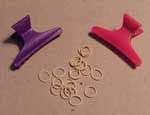 |
|
Show Horse Promotions Mary Murray
|
Banding a horse's maneBanding a horse's mane is a pretty standard procedure for approved showing and for many open shows. It can make your horse's mane lie flat and close to the neck even on a windy day. When the mane lies close to the neck it gives the illusion of a slimmer neck. When you are just starting, it is always a good idea to practice banding your horse's mane early in the week prior to your show. This gives you an idea how long it will take and how well your horse will stand for you while you are banding. When you first start it will usually take several times to get the mane looking as good as you would like it to look, but hang in there, it comes with experience. List of the equipment to have on hand:
1) Spray Quick Braid, spritz a 2" section of mane with the training spray, starting at the bridle path. Next, separate out a ½ inch section of hair. While holding this section, use an alligator clip to hold the mane to the left of you securely out of your way. As you work down the mane, you may need to use an alligator clip on both sides of the mane to keep the hair out of your most current band. The Quick Braid gives you added grip over the hair as well as holding the mane into place when you are finished. 2) Pull the ½" section thru a band holding the hair as close to the neck as possible, wrap the band around the hair sections several times until tight, twisting the band after each loop keeping the hair in the same hand - this forces the twist to always be on the same side of the hair. Keeping the twist underneath is also supposed to help the mane lie flat. 3) Go on to the next section of mane and separate out another ½" section of mane. Repeat the banding procedure, using an alligator clip to keep both sides of the mane out of your way. 4) When you are completely finished, tighten the bands and then trim the excess length off the mane. To tighten a band: from underneath a band, grasp a small section from each side of the band and pull down and outwards staying close to the horse's neck. 5) If you are banding the day prior to your show, use a slinky to keep the mane free of shavings and clean. This also flattens the mane more and on some horses this looks great and on some it looks bad. You need to know which is does for your horse. You can either band the forelock or braid the forelock. Use a quick spritz of Quick Braid before a class to help hold down stray hairs. I do not leave the forelock banded or braided overnight - if the horse rubs the forelock or it the forelock catches on something, the entire forelock could be pulled out or thinned greatly. Depending on the thickness of your horse's mane, you may need to make your sections of hair larger or small than ½". Hints: The below tips will help solve a few problems you may encounter.
© 2000 - 2010 Show Horse Promotions The Show Horse Promotions web site is an informational web site, this information is subject to change without notice. Any use of, or actions taken based upon any of the information contained on this web site is done entirely at your own risk. Show Horse Promotions expressly prohibit you from republishing or redistributing this content without first receiving our written consent. By using this site, you agree not to hold us liable for any errors or delays in this content, or for any actions that you take in reliance thereon. This site contains links to other Internet sites. These links are not endorsements by us of any products or services in those sites, and we have not endorsed or approved any information in those sites. |
|
||||||||


